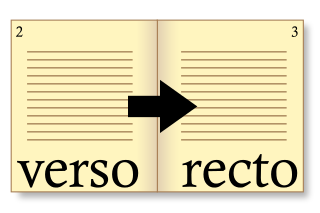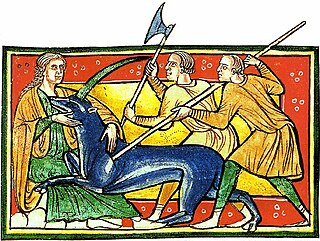
The Aberdeen Bestiary is a 12th-century English illuminated manuscript bestiary that was first listed in 1542 in the inventory of the Old Royal Library at the Palace of Westminster. Due to similarities, it is often considered to be the "sister" manuscript of the Ashmole Bestiary. The connection between the ancient Greek didactic text Physiologus and similar bestiary manuscripts is also often noted. Information about the manuscript's origins and patrons are circumstantial, although the manuscript most likely originated from the 13th century and was owned by a wealthy ecclesiastical patron from north or south England. Currently, the Aberdeen Bestiary resides in the Aberdeen University Library in Scotland.

The Book of Kells is an illuminated manuscript and Celtic Gospel book in Latin, containing the four Gospels of the New Testament together with various prefatory texts and tables. It was created in a Columban monastery in either Ireland or Scotland, and may have had contributions from various Columban institutions from each of these areas. It is believed to have been created c. 800 AD. The text of the Gospels is largely drawn from the Vulgate, although it also includes several passages drawn from the earlier versions of the Bible known as the Vetus Latina. It is regarded as a masterwork of Western calligraphy and the pinnacle of Insular illumination. The manuscript takes its name from the Abbey of Kells, County Meath, which was its home for centuries.

Copy editing is the process of revising written material (copy) to improve readability and fitness, as well as ensuring that a text is free of grammatical and factual errors. The Chicago Manual of Style states that manuscript editing encompasses "simple mechanical corrections through sentence-level interventions to substantial remedial work on literary style and clarity, disorganized passages, baggy prose, muddled tables and figures, and the like ". In the context of print publication, copy editing is done before typesetting and again before proofreading. Outside traditional book and journal publishing, the term "copy editing" is used more broadly, and is sometimes referred to as proofreading; the term sometimes encompasses additional tasks.

APA style is a writing style and format for academic documents such as scholarly journal articles and books. It is commonly used for citing sources within the field of behavioral and social sciences, including sociology, education, nursing, criminal justice, and anthropology, as well as psychology. It is described in the style guide of the American Psychological Association (APA), which is titled the Publication Manual of the American Psychological Association. The guidelines were developed to aid reading comprehension in the social and behavioral sciences, for clarity of communication, and for "word choice that best reduces bias in language". APA style is widely used, either entirely or with modifications, by hundreds of other scientific journals, in many textbooks, and in academia. The current edition is its seventh revision.

Recto is the "right" or "front" side and verso is the "left" or "back" side when text is written or printed on a leaf of paper in a bound item such as a codex, book, broadsheet, or pamphlet.

The Vergilius Romanus, also known as the Roman Vergil, is a 5th-century illustrated manuscript of the works of Virgil. It contains the Aeneid, the Georgics, and some of the Eclogues. It is one of the oldest and most important Vergilian manuscripts. It is 332 by 323 mm with 309 vellum folios. It was written in rustic capitals with 18 lines per page.

In graphic design, page layout is the arrangement of visual elements on a page. It generally involves organizational principles of composition to achieve specific communication objectives.

Book design is the art of incorporating the content, style, format, design, and sequence of the various components and elements of a book into a coherent unit. In the words of renowned typographer Jan Tschichold (1902–1974), book design, "though largely forgotten today, [relies upon] methods and rules upon which it is impossible to improve, [and which] have been developed over centuries. To produce perfect books, these rules have to be brought back to life and applied". Richard Hendel describes book design as "an arcane subject", and refers to the need for a context to understand what that means.

A frontispiece in books is a decorative or informative illustration facing a book's title page, usually on the left-hand, or verso, page opposite the right-hand, or recto page of a book. In some ancient editions or in modern luxury editions the frontispiece features thematic or allegorical elements, in others is the author's portrait that appears as the frontispiece. In medieval illuminated manuscripts, a presentation miniature showing the book or text being presented was often used as a frontispiece.

The term "folio" has three interconnected but distinct meanings in the world of books and printing: first, it is a term for a common method of arranging sheets of paper into book form, folding the sheet only once, and a term for a book made in this way; second, it is a general term for a sheet, leaf or page in (especially) manuscripts and old books; and third, it is an approximate term for the size of a book, and for a book of this size.

Page numbering is the process of applying a sequence of numbers to the pages of a book or other document. The number itself, which may appear in various places on the page, can be referred to as a page number or as a folio. Like other numbering schemes such as chapter numbering, page numbers allow the citation of a particular page of the numbered document and facilitates to the reader to find specific parts of the document and to know the size of the complete text.

An intentionally blank page or vacat page is a page that has no content and may be unexpected. Such pages may serve purposes ranging from place-holding to space-filling and content separation. Sometimes, these pages carry a notice such as "This page intentionally left blank." Such notices typically appear in printed works, such as legal documents, manuals, and exam papers, in which the reader might otherwise suspect that the blank pages are due to a printing error and where missing pages might have serious consequences.
Indicia is the plural of the Latin word indicium, meaning distinguishing marks.

Bookbinding is the process of building a book, usually in codex format, from an ordered stack of paper sheets with one's hands and tools, or in modern publishing, by automated processes. Firstly, one binds the sheets of papers along an edge with a thick needle and strong thread. One can also use loose-leaf rings, binding posts, twin-loop spine coils, plastic spiral coils, and plastic spine combs, but they last for a shorter time. Next, one encloses the bound stack of paper in a cover. Finally, one places an attractive cover onto the boards, and features the publisher's information and artistic decorations.
XFrames is an XML format for combining and organizing web based documents together on a single webpage through the use of frames. Similarly to HTML Frames, XFrames can be made useful through its power to create a content frame that is scrollable while other frames - such as sidebar menus, the header and footer remain in place on the page. XFrames will be particularly useful to web developers who will be able to modify a single document and have that modification appear on all pages that contain the document within a frame.
In typography and word processing, the page footer of a printed page is a section located under the main text, or body. It is typically used as the space for the page number. In the earliest printed books it also contained the first words of the next page; in this case they preferred to place the page number in the page header, in the top margin. Because of the lack of a set standard, in modern times the header and footer are sometimes interchangeable. In some instances, there are elements of the header inserted into the footer, such as the book or chapter title, the name of the author or other information. In the publishing industry the page footer is traditionally known as the running foot, whereas the page header is the running head.

The following outline is provided as an overview of and topical guide to books:

The Worksop Bestiary, also known as the Morgan Bestiary, most likely from Lincoln or York, England, is an illuminated manuscript created around 1185, containing a bestiary and other compiled medieval Latin texts on natural history. The manuscript has influenced many other bestiaries throughout the medieval world and is possibly part of the same group as the Aberdeen Bestiary, Alnwick Bestiary, St.Petersburg Bestiary, and other similar Bestiaries. Now residing in the Morgan Library & Museum in New York, the manuscript has had a long history of church, royal, government, and scholarly ownership.

Papyrus 137, is an early fragment of the New Testament in Greek. The fragment is from a codex, written on both sides with text from the first chapter of the Gospel of Mark; verses 7–9 on the recto side and 16–18 on the verso side. The manuscript has been dated paleographically to the later 2nd or earlier 3rd century, and has been published in the Oxyrhynchus papyrus series as P.Oxy. LXXXIII 5345.





















